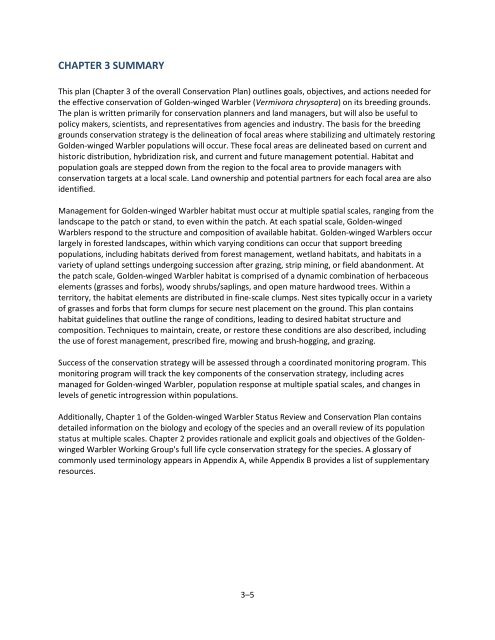Review and download Chapter 3 - Golden-winged Warbler Working ...
Review and download Chapter 3 - Golden-winged Warbler Working ...
Review and download Chapter 3 - Golden-winged Warbler Working ...
Create successful ePaper yourself
Turn your PDF publications into a flip-book with our unique Google optimized e-Paper software.
CHAPTER 3 SUMMARY<br />
This plan (<strong>Chapter</strong> 3 of the overall Conservation Plan) outlines goals, objectives, <strong>and</strong> actions needed for<br />
the effective conservation of <strong>Golden</strong>-<strong>winged</strong> <strong>Warbler</strong> (Vermivora chrysoptera) on its breeding grounds.<br />
The plan is written primarily for conservation planners <strong>and</strong> l<strong>and</strong> managers, but will also be useful to<br />
policy makers, scientists, <strong>and</strong> representatives from agencies <strong>and</strong> industry. The basis for the breeding<br />
grounds conservation strategy is the delineation of focal areas where stabilizing <strong>and</strong> ultimately restoring<br />
<strong>Golden</strong>-<strong>winged</strong> <strong>Warbler</strong> populations will occur. These focal areas are delineated based on current <strong>and</strong><br />
historic distribution, hybridization risk, <strong>and</strong> current <strong>and</strong> future management potential. Habitat <strong>and</strong><br />
population goals are stepped down from the region to the focal area to provide managers with<br />
conservation targets at a local scale. L<strong>and</strong> ownership <strong>and</strong> potential partners for each focal area are also<br />
identified.<br />
Management for <strong>Golden</strong>-<strong>winged</strong> <strong>Warbler</strong> habitat must occur at multiple spatial scales, ranging from the<br />
l<strong>and</strong>scape to the patch or st<strong>and</strong>, to even within the patch. At each spatial scale, <strong>Golden</strong>-<strong>winged</strong><br />
<strong>Warbler</strong>s respond to the structure <strong>and</strong> composition of available habitat. <strong>Golden</strong>-<strong>winged</strong> <strong>Warbler</strong>s occur<br />
largely in forested l<strong>and</strong>scapes, within which varying conditions can occur that support breeding<br />
populations, including habitats derived from forest management, wetl<strong>and</strong> habitats, <strong>and</strong> habitats in a<br />
variety of upl<strong>and</strong> settings undergoing succession after grazing, strip mining, or field ab<strong>and</strong>onment. At<br />
the patch scale, <strong>Golden</strong>-<strong>winged</strong> <strong>Warbler</strong> habitat is comprised of a dynamic combination of herbaceous<br />
elements (grasses <strong>and</strong> forbs), woody shrubs/saplings, <strong>and</strong> open mature hardwood trees. Within a<br />
territory, the habitat elements are distributed in fine-scale clumps. Nest sites typically occur in a variety<br />
of grasses <strong>and</strong> forbs that form clumps for secure nest placement on the ground. This plan contains<br />
habitat guidelines that outline the range of conditions, leading to desired habitat structure <strong>and</strong><br />
composition. Techniques to maintain, create, or restore these conditions are also described, including<br />
the use of forest management, prescribed fire, mowing <strong>and</strong> brush-hogging, <strong>and</strong> grazing.<br />
Success of the conservation strategy will be assessed through a coordinated monitoring program. This<br />
monitoring program will track the key components of the conservation strategy, including acres<br />
managed for <strong>Golden</strong>-<strong>winged</strong> <strong>Warbler</strong>, population response at multiple spatial scales, <strong>and</strong> changes in<br />
levels of genetic introgression within populations.<br />
Additionally, <strong>Chapter</strong> 1 of the <strong>Golden</strong>-<strong>winged</strong> <strong>Warbler</strong> Status <strong>Review</strong> <strong>and</strong> Conservation Plan contains<br />
detailed information on the biology <strong>and</strong> ecology of the species <strong>and</strong> an overall review of its population<br />
status at multiple scales. <strong>Chapter</strong> 2 provides rationale <strong>and</strong> explicit goals <strong>and</strong> objectives of the <strong>Golden</strong><strong>winged</strong><br />
<strong>Warbler</strong> <strong>Working</strong> Group's full life cycle conservation strategy for the species. A glossary of<br />
commonly used terminology appears in Appendix A, while Appendix B provides a list of supplementary<br />
resources.<br />
3–5


